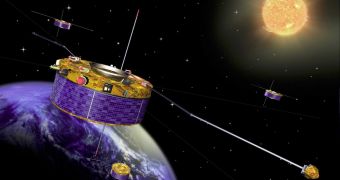Samba and Tango are the names of two of ESA's four satellites in the Cluster mission that are now orbiting in formation, separated by only 17 km, the closest two ESA satellites have ever been. It is hoped that this tight formation will allow new scientific discoveries about the Sun and the solar wind.
The Cluster mission is a European Space Agency (ESA) unmanned space mission to study the Earth's magnetosphere using four identical spacecraft flying in a tetrahedral formation. They are used to examine the protective magnetosphere of the Earth that shields us from the continual solar wind.
Now, the two satellites are "dancing" closer together, as they never did before, since the distance between them usually varies from around 100 to 10000 kilometers (km). "In the new orientation it is possible to monitor very minute fluctuations in the thin 'neutral sheet' with a high spatial resolution, as we simultaneously perform two measurements very close together," says Juergen Volpp, Cluster Spacecraft Operations Manager at ESA's European Spacecraft Operations Centre (ESOC), in Germany.
"The inter spacecraft distance of 17 km is approaching the limits of what can be attained with Cluster, where the four spacecraft are operated independently," says Detlef Sieg, flight dynamics engineer at ESOC. "Future missions will need inter-satellite communication systems to achieve even smaller distances."
Each satellite carries a scientific payload of 11 instruments designed to study the small-scale plasma structures in space and time in the key plasma regions: the solar wind and bow shock, magnetopause, polar cusps, magnetotail and the auroral zone.
Last month, the Cluster mission made an amazing discovery. They found a shock wave - a natural phenomenon found above the Earth's surface, on the side facing the Sun, at 96,100 kilometers (59,700 miles), at around a quarter of the distance to the Moon - that kept breaking and reforming, a model predicted only in theory but never actually seen in space.

 14 DAY TRIAL //
14 DAY TRIAL //